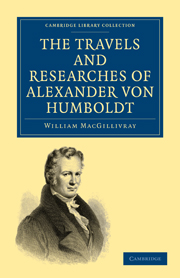 The Travels and Researches of Alexander von Humboldt
The Travels and Researches of Alexander von Humboldt Book contents
- Frontmatter
- PREFACE
- Contents
- CHAPTER I INTRODUCTION
- CHAPTER II VOYAGE FROM CORUNNA TO TENERIFFE
- CHAPTER III ISLAND OF TENERIFFE
- CHAPTER IV PASSAGE FROM TENERIFFE TO CUMANA
- CHAPTER V CUMANA
- CHAPTER VI RESIDENCE AT CUMANA
- CHAPTER VII MISSIONS OF THE CHAYMAS
- CHAPTER VIII EXCURSION CONTINUED, AND RETURN TO CUMANA
- CHAPTER IX INDIANS OF NEW ANDALUSIA
- CHAPTER X RESIDENCE AT CUMANA
- CHAPTER XI VOYAGE FROM CUMANA TO GUAYBA
- CHAPTER XII CITY OF CARACCAS AND SURROUNDING DISTRICT
- CHAPTER XIII EARTHQUAKES OF CARACCAS
- CHAPTER XIV JOURNEY FROM CARACCAS TO THE LAKE OF VALENCIA
- CHAPTER XV JOURNEY ACROSS THE LLANOS, FROM ARAGUA TO SAN FERNANDO
- CHAPTER XVI VOYAGE DOWN THE RIO APURE
- CHAPTER XVII VOYAGE UP THE ORINOCO
- CHAPTER XVIII VOYAGE UP THE ORINOCO CONTINUED
- CHAPTER XIX ROUTE FROM ESMERALDA TO ANGOSTURA
- CHAPTER XX JOURNEY ACROSS THE LLANOS TO NEW BARCELONA
- CHAPTER XXI PASSAGE TO HAVANNAH, AND RESIDENCE IN CUBA
- CHAPTER XXII VOYAGE FROM CUBA TO CARTHAGENA
- CHAPTER XXIII BRIEF ACCOUNT OF THE JOURNEY FROM CARTHAGENA TO QUITO AND MEXICO
- CHAPTER XXIV DESCRIPTION OF NEW SPAIN OR MEXICO
- CHAPTER XXV STATISTICAL ACCOUNT OF NEW SPAIN CONTINUED
- CHAPTER XXVI MINES OF NEW SPAIN
- CHAPTER XXVII PASSAGE FROM VERA CRUZ TO CUBA AND PHILADELPHIA, AND VOYAGE TO EUROPE
- CHAPTER XXVIII JOURNEY TO ASIA
CHAPTER XXI - PASSAGE TO HAVANNAH, AND RESIDENCE IN CUBA
Published online by Cambridge University Press: 29 August 2010
- Frontmatter
- PREFACE
- Contents
- CHAPTER I INTRODUCTION
- CHAPTER II VOYAGE FROM CORUNNA TO TENERIFFE
- CHAPTER III ISLAND OF TENERIFFE
- CHAPTER IV PASSAGE FROM TENERIFFE TO CUMANA
- CHAPTER V CUMANA
- CHAPTER VI RESIDENCE AT CUMANA
- CHAPTER VII MISSIONS OF THE CHAYMAS
- CHAPTER VIII EXCURSION CONTINUED, AND RETURN TO CUMANA
- CHAPTER IX INDIANS OF NEW ANDALUSIA
- CHAPTER X RESIDENCE AT CUMANA
- CHAPTER XI VOYAGE FROM CUMANA TO GUAYBA
- CHAPTER XII CITY OF CARACCAS AND SURROUNDING DISTRICT
- CHAPTER XIII EARTHQUAKES OF CARACCAS
- CHAPTER XIV JOURNEY FROM CARACCAS TO THE LAKE OF VALENCIA
- CHAPTER XV JOURNEY ACROSS THE LLANOS, FROM ARAGUA TO SAN FERNANDO
- CHAPTER XVI VOYAGE DOWN THE RIO APURE
- CHAPTER XVII VOYAGE UP THE ORINOCO
- CHAPTER XVIII VOYAGE UP THE ORINOCO CONTINUED
- CHAPTER XIX ROUTE FROM ESMERALDA TO ANGOSTURA
- CHAPTER XX JOURNEY ACROSS THE LLANOS TO NEW BARCELONA
- CHAPTER XXI PASSAGE TO HAVANNAH, AND RESIDENCE IN CUBA
- CHAPTER XXII VOYAGE FROM CUBA TO CARTHAGENA
- CHAPTER XXIII BRIEF ACCOUNT OF THE JOURNEY FROM CARTHAGENA TO QUITO AND MEXICO
- CHAPTER XXIV DESCRIPTION OF NEW SPAIN OR MEXICO
- CHAPTER XXV STATISTICAL ACCOUNT OF NEW SPAIN CONTINUED
- CHAPTER XXVI MINES OF NEW SPAIN
- CHAPTER XXVII PASSAGE FROM VERA CRUZ TO CUBA AND PHILADELPHIA, AND VOYAGE TO EUROPE
- CHAPTER XXVIII JOURNEY TO ASIA
Summary
Humboldt and his companion sailed from the Road of New Barcelona on the 24th November at nine in the evening, and next day at noon reached the island of Tortuga, remarkable for its lowness and want of vegetation. On the 26th there was a dead calm, and about nine in the morning a fine halo formed round the sun, while the temperature of the air fell three degrees. The circle of this meteor, which was one degree in breadth, displayed the most beautiful colours of the rainbow, while its interior and the whole vault of the sky was azure without the least haze. The sea was covered with a bluish scum, which under the microscope appeared to be formed of filaments, that seemed to be fragments of fuci. On the 27th they passed near the island of Orchila, composed of gneiss and covered with plants, and toward sunset discovered the summits of the Roca de Afuera, over which the clouds were accumulated. Indications of stormy weather increased, the waves rose, and waterspouts threatened. On the night of the 2d December a curious optical phenomenon presented itself. The full moon was very high. On its side, forty-five minutes before its passage over the meridian, a great arc suddenly appeared, having the prismatic colours, but of a gloomy aspect. It seemed higher than the moon, had a breadth of nearly two degrees, and remained stationary for several minutes; after which it gradually descended, and sank below the horizon.
- Type
- Chapter
- Information
- The Travels and Researches of Alexander von HumboldtBeing a Condensed Narrative of his Journeys in the Equinoctial Regions of America, and in Asiatic Russia; Together with Analyses of his More Important Investigations, pp. 298 - 308Publisher: Cambridge University PressPrint publication year: 2009First published in: 1832


